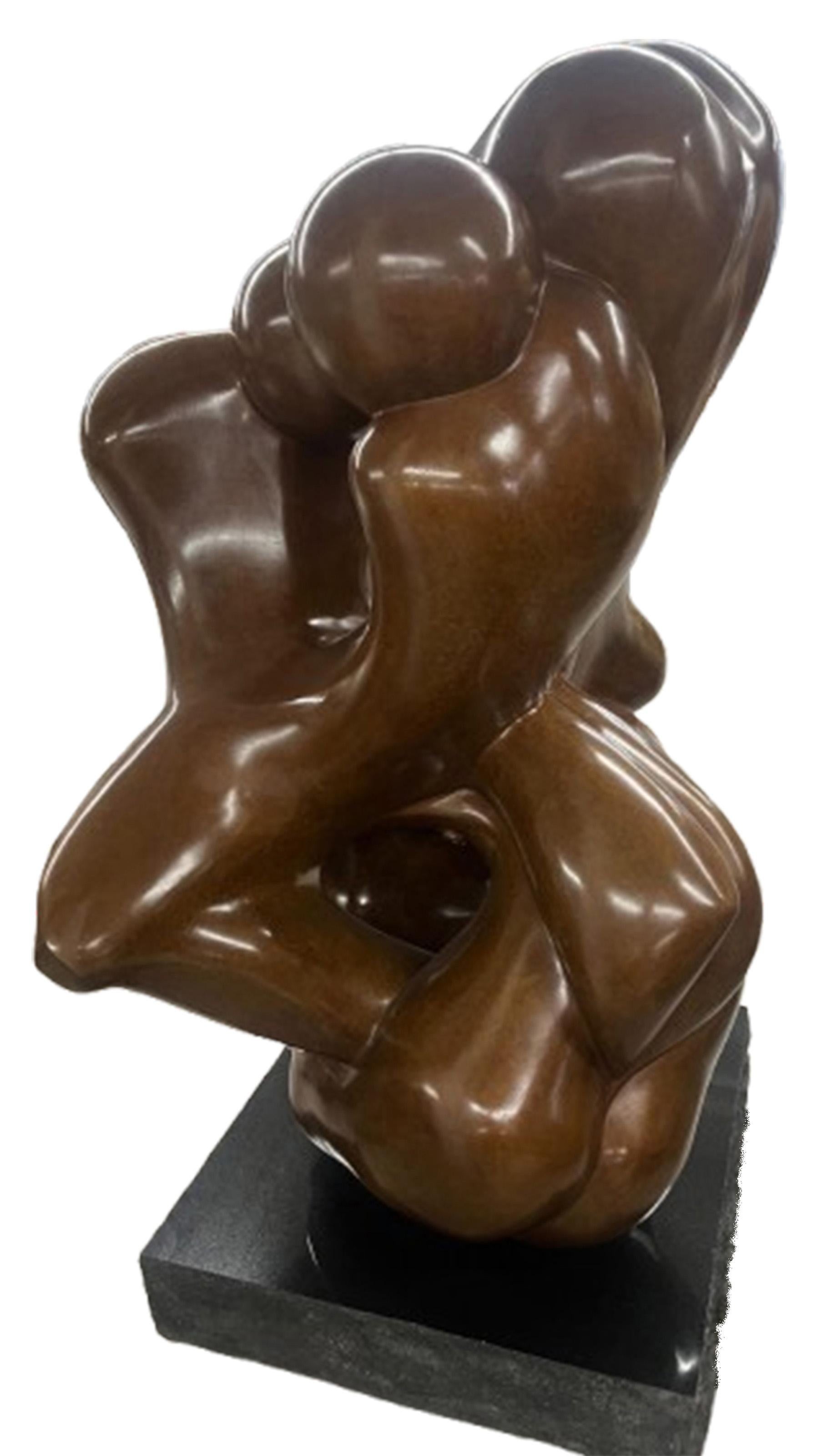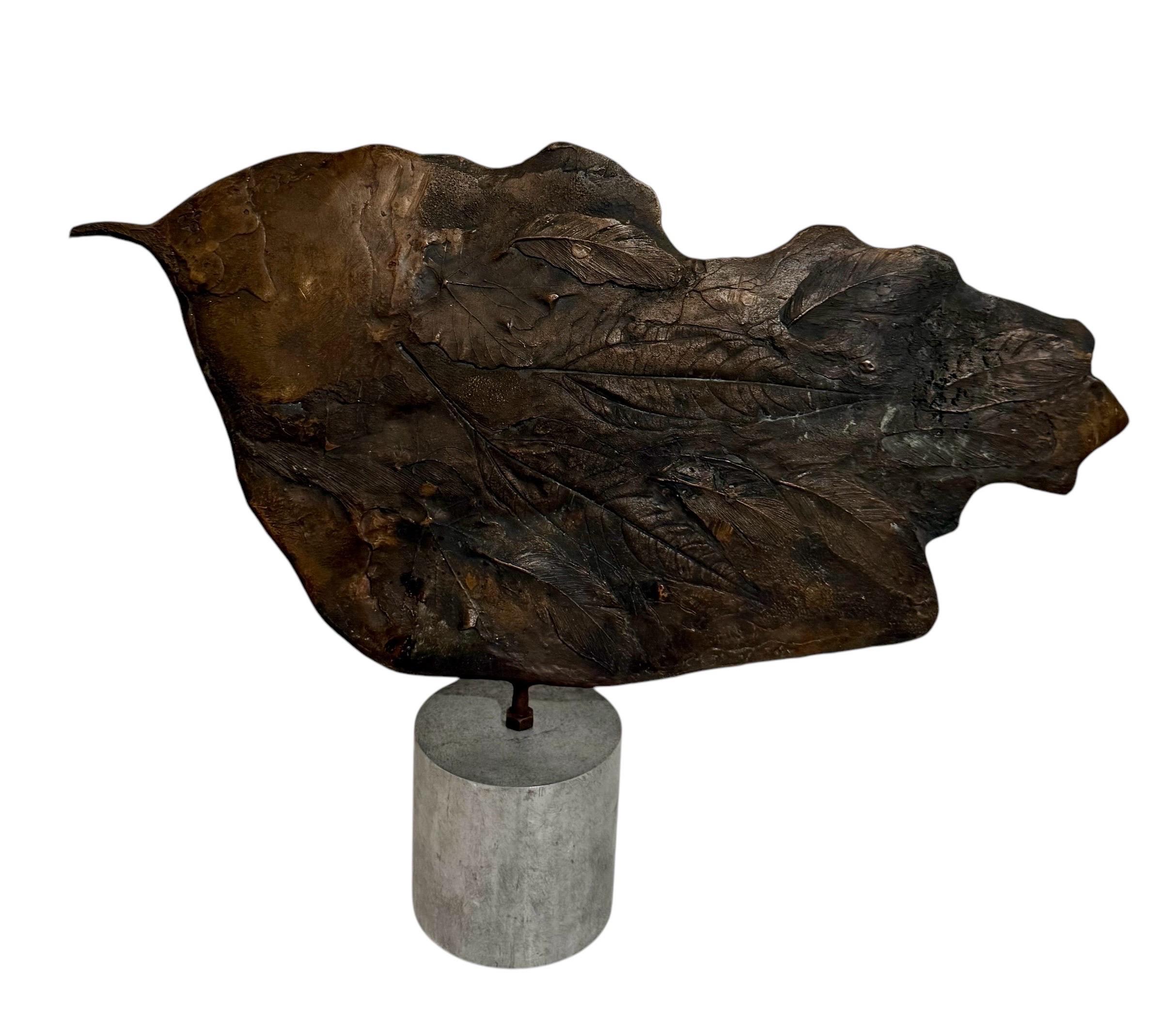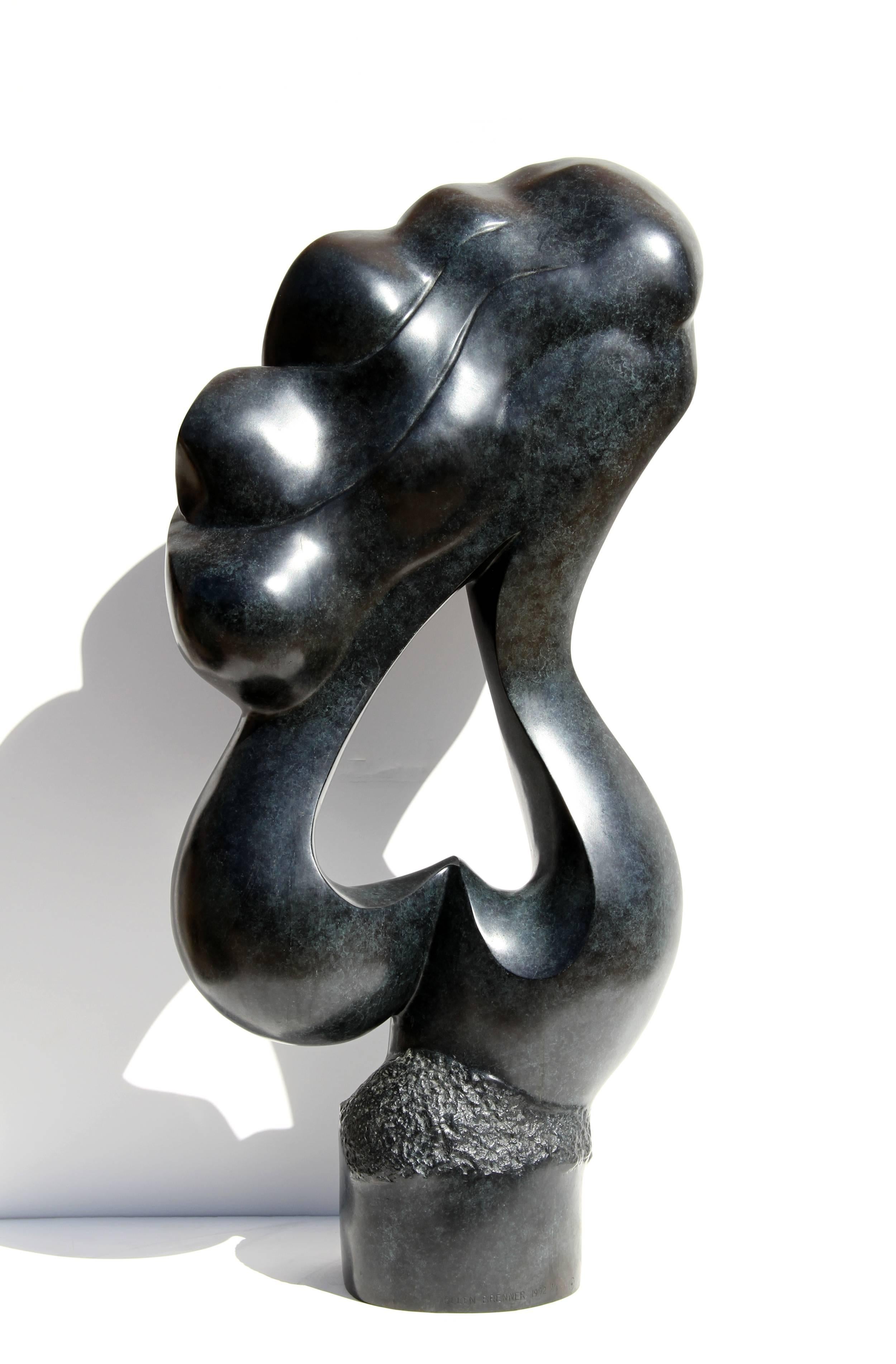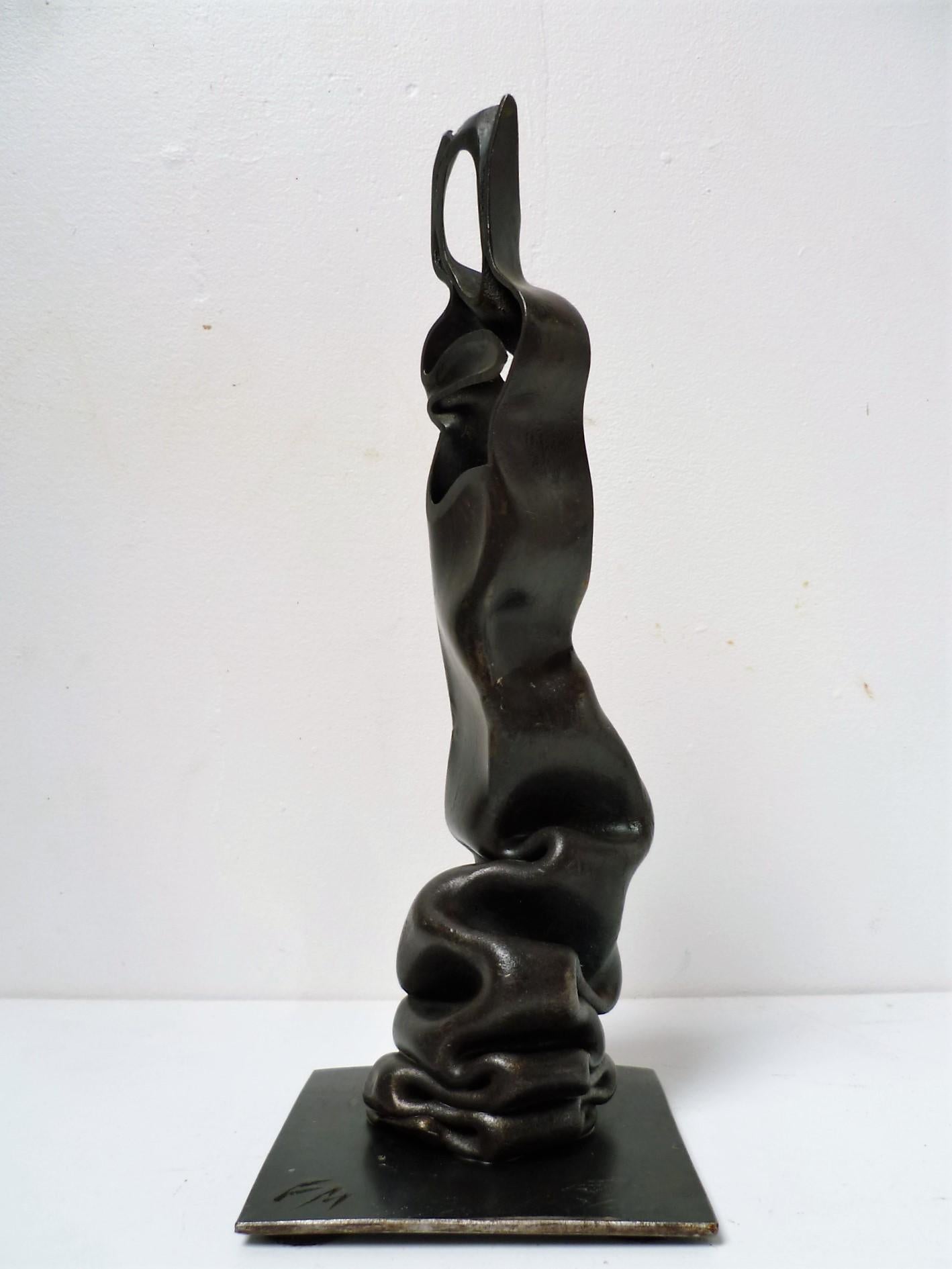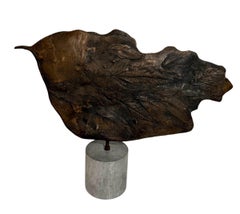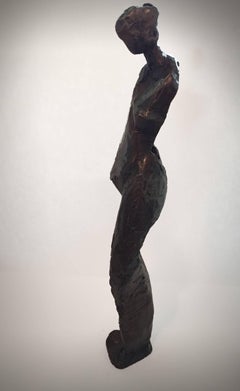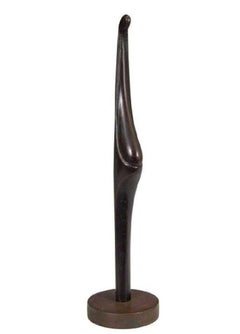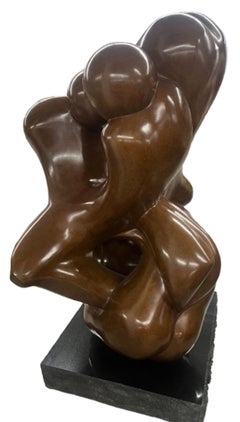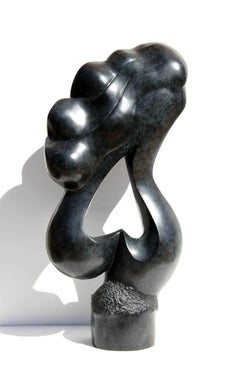Items Similar to Latin American Art Figurative Abstract Bronze Sculpture Lovers Marcelo Morandin
Want more images or videos?
Request additional images or videos from the seller
1 of 13
Marcelo MorandinLatin American Art Figurative Abstract Bronze Sculpture Lovers Marcelo Morandin1988
1988
$1,800
£1,357.67
€1,568.12
CA$2,521.92
A$2,804.23
CHF 1,468.07
MX$34,254.25
NOK 18,447.71
SEK 17,353.77
DKK 11,705.88
About the Item
Marcelo Morandin 1933-1996
Untitled (Embracing Couple, Lovers)
Bronze 1988; ed. P/E; Hand signed, dated and editioned to lower edge DImensions: 48.5 x 32 x 21 cm / 18.8 x 12.5 x 8.2 inches (approximately)
PAREJA, Bronce, patinado
Marcelo Morandin (1933 - 1996) was active/lived in Argentina, Mexico.
Argentinian, Mexican Postwar & Contemporary sculptor Morandin is best known for his monumental sculpture. This is a wonderful, art deco inspired nude couple, the woman appears pregnant).
Marcello Morandín (Marcelo Román Morandín Paroni) was born in 1933 in Argentina. He was an important plastic artist and Argentine architect, distinguished in Mexico for being an excellent sculptor and furniture designer. At the end of his studies at the Faculty of Architecture of Buenos Aires, Argentina, he traveled to Mexico and settled in Xalapa, Veracruz. In this city he was part of several artistic projects and noted for being one of the founders of the Department of Aesthetic Research and Applied Design at the University of Veracruz, as well as the Department of Aesthetic Research at UNAM. Between the years 80 and 90, he carried out several monumental works, among them "La pigeon de la paz" a project for the UN; "The foundation of Tenochtitlan" located in front of the Official Residence of Los Pinos; and "The Kinetic Tower" Of the government of Veracruz that combines the light and the sound with diverse moving parts to the compass of the music of Arnold Schoenberg. (Lily Kassner. Dictionary of Mexican sculptors of the twentieth century. Volume II. Mexico. Conaculta, 1997). Similar in style to Israeli artists Aharon Bezalel and Isaac Kahn.
He has shown with Jose Villalobos, Nicolas Moreno, Pedro Cervantes, Vicente Rojo, Carmen Parra, Abel Benitez, Alberto Ramirez Jurado, Ignacio Ortiz, Armando Villagran, Gabriel Macotela, Wuero Ramos, Victor Chaca, Guillermo William Scully, Arturo Estrada, Shinzaburo Takeda, Trinidad Osorio, Guillermo Ceniceros, Xavier Esqueda, Omar Manueco, Alberto Castro Lenero. He was the teacher of Bruno Luna.
He has sold at Galeria Las Lieos, Mexico and Morton Subastas.
- Creator:Marcelo Morandin (1933 - 1996, Argentinian, Mexican)
- Creation Year:1988
- Dimensions:Height: 18 in (45.72 cm)Width: 10 in (25.4 cm)Depth: 5.75 in (14.61 cm)
- Medium:
- Period:
- Condition:minor wear to patina commensurate with age and use. please see photos.
- Gallery Location:Surfside, FL
- Reference Number:1stDibs: LU38214658492
About the Seller
4.9
Platinum Seller
Premium sellers with a 4.7+ rating and 24-hour response times
Established in 1995
1stDibs seller since 2014
1,799 sales on 1stDibs
Typical response time: <1 hour
- ShippingRetrieving quote...Shipping from: Surfside, FL
- Return Policy
Authenticity Guarantee
In the unlikely event there’s an issue with an item’s authenticity, contact us within 1 year for a full refund. DetailsMoney-Back Guarantee
If your item is not as described, is damaged in transit, or does not arrive, contact us within 7 days for a full refund. Details24-Hour Cancellation
You have a 24-hour grace period in which to reconsider your purchase, with no questions asked.Vetted Professional Sellers
Our world-class sellers must adhere to strict standards for service and quality, maintaining the integrity of our listings.Price-Match Guarantee
If you find that a seller listed the same item for a lower price elsewhere, we’ll match it.Trusted Global Delivery
Our best-in-class carrier network provides specialized shipping options worldwide, including custom delivery.More From This Seller
View AllLarge Latin American Modernist Bronze Abstract Cuban Master Roberto Estopinan
By Roberto Estopiñan
Located in Surfside, FL
Roberto Estopinan, Cuban, 1920 - 2015
Dimensions: 24.5" wide x 13" high plus 6" high base.
Roberto Estopiñán (1921–2015) was a Cuban American sculptor known for his sculptures of the human form, including political prisoners. Born in Camaguey, Cuba, he lived in the United States for over fifty years. His works are held by major institutions such as the Museum of Modern Art, the Whitney Museum and the Smithsonian Museum of American Art.
Roberto Gabriel Estopinan, a sculptor, draftsman, and printmaker, was born in Havana, Cuba on March 18, 1921. Estopiñán enrolled at the San Alejandro Academy when he was just 14 years old and became the protegé and studio assistant of the sculptor Juan José Sicre. After graduation he traveled first to Mexico, where he met and befriended Francisco Zuniga, and studied Pre-Columbian sculpture. In 1949 he traveled to Europe, visiting England, France and Italy. In these trips he encountered the sculpture of Henry Moore and Marino Marini, and their humanistic yet formal visions would be influential on Estopinan's work. Estopiñán was a pioneer of direct carvings using wood and of welding techniques in Latin America. Throughout the 1950s, Estopiñán received important prizes at various national exhibitions in Havana. In 1953 he was the only semi-finalist from Latin America at the Tate Gallery's international sculpture competition for a Monument to the Unknown Political Prisoner. In 1961, the artist moved to New York, where he resided until 2002.
Roberto Gabriel Estopiñán a Cuban emigre sculptor who emigrated to exile in the United States not long after Fidel Castro’s revolution in 1959, is considered one of Latin America’s most important 20th-century artists. His work, which includes drawings and prints as well as sculptures in wood and bronze, is in the collections of New York’s Museum of Modern Art, the Smithsonian’s American Art Museum, the Art Institute of Chicago, and the Detroit Institute of Art, among many locations. He is best known for his stark, disturbing renderings of political prisoners, the fruit of his own experiences as a dissident under both Castro and his predecessor, the dictator Fulgencio Batista, and for his representations of the female torso that can remind viewers of both classical statuary and the high-modern, abstractly elongated work of Henry Moore.mHe was born in Havana to a father from Asturias in northwest Spain and a mother of African descent. Estopiñán was something of a prodigy. At the age of fourteen, he won the first prize in drawing at the Centro Asturiano, a regional association for Cubans of Asturian descent. Shortly afterward he received special permission to enter the San Alejandro Academy of Fine Arts in Havana. At the school he was mentored first by its director, the painter Armando Menocal (1863-1941), then by the landscape artist Antonio Rodríguez Morey (1872-1967), and finally by Juan José Sicre (1898-1974), regarded as one of Cuba’s greatest sculptors. Sicre, a professor of sculpture at the Academy, had helped introduce European modernist art to Cuba, and from the 1930s through the 1950s had sculpted monumental figures in Havana of José Martí and other Cuban national heroes that stand to this day. Estopiñán was first Sicre’s student, then his assistant, and, finally, his colleague for the next fifty years. After graduating from San Alejandro in 1942, Estopiñán began simultaneously teaching art at the Ceiba del Agua School for young men, assisting Sicre in public art projects and developing his own artistic vision. He also traveled widely, to Mexico, New York, France, and Italy. From the late 1940s through the 1950s his sculpture evolved from an early neoclassical phase under the influence of Maillol to what he defined as “formalist humanism”: emphasizing the abstract beauty of the shapes he sculpted while not abandoning the human figure as the basis of his work. As the 1950s progressed he chose to carve in native Cuban woods...
Category
20th Century Abstract Figurative Sculptures
Materials
Bronze
Unknown Israeli Bronze
Located in Surfside, FL
Bronze figurative sculpture
Unknown Israeli Artist
Category
20th Century Figurative Sculptures
Materials
Bronze
Israeli Bronze Modernist Sculpture Pregnant Woman Abstract Figure Safed, Ein-Hod
By Victor Halvani
Located in Surfside, FL
From a limited edition. an abstract elongated art deco form of a mother with child.
signed on bottom of wooden base and etched into bronze.
Victor Halvani no doubt had an enchanted childhood. A warm loving Jewish family. His father a judge, his mother, descendent from a rabbinic family, was a great storyteller who transformed the heroes of the Bible into her child’s best friends. A small village at the base of the pyramids of Giza, school trips to the Valley of the Kings in Aswan. Ancient Egyptian art looking at the dreamy child from every corner. Given the chance to look back, it becomes clear that Victor’s lifelong dream – to become an artist, had it’s beginnings right there – in the child dreaming at the Nile.
Victor Halvany was born in 1930 to Bella and Yitzchak (OBM). Soaked in that enchanted childhood atmosphere, Victor found himself spending hours and days in the Cairo museum of art, looking at the exhibits and drawing them with intensity and enthusiasm. His inspiration filled drawings caught the eye of his teachers and with there encouragement he entered a national competition in which he won first place. This lead to him winning a full scholarship at the art faculty in Zamalek and at the Cairo University. Full of hopes and dreams he began his studies, only to be interrupted after one year. The Israeli war of independence began and subsequently the pogroms, and the urgent need of Egyptian Jews to emigrate, going first to France and than to Israel. Victor’s first years in Israel were years of struggle for survival, but simultaneously years of activity and progress. In 1950, while serving in the army, Victor met Margalit, the women at his side, mother of his children and the most present character in his career of activity and art. With Margalit’s encouragement and support he not only raised a family, fathering two boys and a girl, but also fulfilled his dream and was fortunate to have a full and inspiring career- as a person, artist, and teacher. Today, in his advanced age, Victor continues his daily activities: creates, plans, exhibits, and as always – open-minded, curious, learning, getting updated.
1953 – Received scholarship and year of study at Bezalel School of art and design in Jerusalem.
1956 – Finished education studies and received BA in education. Tel Aviv art teachers college.
1969 – Scholarship to study abroad for a year at Hammersmith College of art & building in London, graduating cum laude.
1970 – Received MA in art education and sculpture.
2015 – Participation in the sculpture exhibit at the Mamilla mall promenade in Jerusalem. Sculptures exhibited:
“David with harp”, “Mother playing with child”, “Yuval father of harp players”
2014 – Participation in sculpture exhibit at the Mamilla Mall Promenade in Jerusalem, sculptures exhibited:
“Ruth and Naomi” “David playing harp”, “Girl with gazelle”
2013 – Ein Hod, Yemini sculpture garden, at main entrance to artist’s colony, sculpture exhibited “David playing the harp”.
2012 – Opening of “Art exhibit- Victor Halvani”. At the Halvani residence in Ein Hod, exhibits large collection of sculptures and prints. Visits by appointment.
2011 – Safed, “The Shofar” art project, exhibited at “Safed liberation square”, at main entrance to the city, in the presence of the mayor and representatives of U.S. donors.
2010 – Safed, “The Spies” art project placed, and square named Halvani, at southern entrance to the city of Safed, in presence of the Mayor, Ilan Shochet, and representatives of U.S. donors.
2001 – Participation in international exhibit in San Francisco, U.S.
2001 – Katzrin, Ramat Hagolan, Exhibit of sculptures “Mother playing with child”, “Hope for peace”, and “David with slingshot”, around the city.
2000 – New York, U.S. – International millennium art expo – exhibited “The Hope”.
1999 – Safed, completion of phase 2 of Victor Halvani sculpture garden in Oranim neighborhood.
1998 – Bennington, U.S. – Solo exhibit with collection of bronze sculptures at Bennington art center.
1997 – Stillwater, Oklahoma, U.S. – Placement of sculpture “David playing the harp” at the entrance to Seretean art center at the University of Oklahoma.
1996 – Miami, Florida, U.S., Center for international exhibits – solo exhibit, selection of bronze sculptures.
1995 – West Bloomfield, Michigan, U.S. – Placement of sculpture “David playing harp” at the Reform Jewish Cultural Center park.
1995 – Boston, U.S. – placement of sculpture “David playing harp” at Stanley & Barbara Young...
Category
20th Century Contemporary Figurative Sculptures
Materials
Bronze
Argentine Modernist Brutalist Abstract Bronze Sculpture Jewish Latin American
By Naum Knop
Located in Surfside, FL
Naum Knop (Ukrainian-Argentinean, 1917-1993) Modernist Brutalist bronze figural sculpture with heavy verdigris green finish. Melted forms in the shape of an abstract pretzel like twist. Affixed to white stone plinth. Artist signature, "NK" side of base. Good condition, shows rich green patina and aged oxidation. Measures approximately 17.5 in. x 19.5 in. x 6.5 in.
Naum Knop, Argentine sculptor, was born in 1917 in Buenos Aires, into a Jewish family of Russian origin from Ukraine. His childhood was spent in the neighborhood of La Paternal where his father had a carpentry workshop, a space in which he made contact for the first time with the technique of wood carving. After finishing elementary school, he worked with the teacher Luis Fernández and soon after he dedicated himself to furniture design. Around 1935, he entered the Manuel Belgrano School of Fine Arts . Between 1941 and 1942 he attended the course for graduates taught by Alberto Lagos and Alfredo Bigatti at the National School of Fine Arts and continued his training between 1942-1945 at the Ernesto de la Cárcova High School with Soto Avedaño, Carlos de la Cárcova and José Fioravanti. At this time he put his works in dialogue with other young artists such as Libero Badii and Aurelio Macchi .
Around 1947 he made his study trip abroad. He goes to California, United States, where he enters the Art Institute of Los Angeles. At the same time visit museums and galleries. In January 1948 he organized his first exhibition abroad, held at the Hall of Arts in Beverly Hills in Los Angeles. During this period he toured Chicago and then New York. That year he traveled to Europe; his itinerary includes France, Italy, Switzerland and England. As a result, he came into contact with the work of Henry Moore, Hans Jean Arp, Jacques Lipchitz, Constantin Brancusi, Umberto Boccioni, Henry Laurens, Ossip Zadkine. Artists who have an impact on the young Knop and whom he honors in his subsequent production. He returned to Argentina in 1949 and installed his workshop where he worked on ornamental carving and on pieces in which he oscillated between a synthetic figuration and abstraction.
In 1956 he began his successful participation in salons , obtaining numerous awards at the national and municipal level. In 1959 he participated in the shipment to the 5th São Paulo Biennial and since then, to the success achieved at the local level, the multiple exhibitions carried out in the international field have been added. The exhibitions in Tel Aviv , Jerusalem and Rome (1966) stand out; Dusseldorf (1977); Los Angeles and Palm Spring (1981); New York (1986), San Pablo and Los Angeles(1989). During this period, his work matured, while he began to experiment with the direct wax technique, obtaining textured surfaces similar to welds that gave it a strong abstract expressionist feature. In parallel to his personal production and to the small models, the artist receives private and public commissions for which he works on large-scale sculptures and murals. Around 1967, the architect Mario R. Álvarez summons him to participate in a closed competition for the creation of a work to be located in the General San Martín Cultural Center . Libero Badii and Enio Iommi participate with the artist ; the bronze Reclining Figure Knop is chosen. Among the large-scale monuments it is worth remembering the piece Los tres soles temporarily located in Recoleta in 1984 and later installed in Maryland, United States; as well as Seated Figure (Reminiscence of Michelangelo) located in the shield of a private building in 1970. To these are added the numerous murals in which he experiments with various materials and techniques such as casting in bronze, openwork and reliefs in wood and work in cement.
He was included in the The 1962 International Prize for Sculpture the jury included Argan, Romero Brest and James Johnson Sweeney the former director of the Solomon R. Guggenheim Museum in New York. The participants included Louise Nevelson and John Chamberlain for the United States; Lygia Clark for Brazil; Pietro Consagra, Lucio Fontana, Nino Franchina, and Gió Pomodoro for Italy; Pablo Serrano for Spain; and Eduardo Paolozzi, William Turnbull, and Kenneth Armitage for England. Gyula Kosice, Noemí Gerstein, Julio Gero, Naum Knop, Aldo Paparella, Enrique Romano, Eduardo Sabelli, and Luis Alberto...
Category
Mid-20th Century Abstract Abstract Sculptures
Materials
Stone, Bronze
Chester Williams, Black Artist, Abstract Bronze, Wood African American Sculpture
Located in Surfside, FL
Chester L. Williams
Label on bottom, signed. Title: Promethium
Medium: Bronze, Aluminum and wood.
Approx. dimensions: 12 X 11 X 4 inches.
Chester Lee Williams (1944-1919) was born in 1944, in Durham, North Carolina. Chester cultivated a creative mind that eventually led him to pursue an education in fine arts and sculpture at North Carolina Central University (BA) and the University of Michigan (MFA). In 1974, he made his way to Tallahassee and started instructing at FAMU. Students at the university have a deep appreciation for the jazz lover’s insight and skill. A lifelong artist, Chester's work has been featured in galleries and publications across the country. The body of his work produced over 45 years has evolved from smooth and supple sculptures into the more angular and defiant shapes seen in his later works. Chester has said: "All of the works are me. I still embrace every one of them." Chester enjoyed traveling and exploring different cultures. His art was influenced by his travel and knowledge of African culture. He was an educator for 37 years, teaching at Voorhees College, North Carolina Central University and Florida A&M University before retiring in 2011.
He sold his first piece of art in the ninth grade to his homeroom teacher. (That early sale paid off — years later, that teacher’s husband, the president of a bank, commissioned Williams to create a sculpture for the bank’s lobby...
Category
20th Century Abstract Abstract Sculptures
Materials
Metal, Bronze
Brutalist Bronze Abstract Modernist Sculpture
Located in Surfside, FL
In the manner of Julio Gonzalez, mixed metal sculpture.
Neo-Dada Abstract Sculpture: Assemblages
Abstract sculpture followed a slightly different course. Rather than focusing on non-figurative subject matter, it concentrated on materials, hence the emergence of Assemblage Art - a form of three-dimensional visual art made from everyday objects, said to be 'found' by the artist (objets trouves). Popular in the 1950s and 1960s in America, assemblage effectively bridged the gap between collage and sculpture, while its use of non-art materials - a feature of Neo-Dada art - anticipated the use of mass-produced objects in Pop-Art. Assemblage sculpture is exemplified by the works of Louise Nevelson (1899-1988), such as Mirror Image 1 (1969, Museum of Fine Arts, Houston), and by Jean Dubuffet (1901-85) and his Monument with Standing Beast (1960, James R. Thompson Center, Chicago). The idiom was considerably boosted by an important exhibition - "The Art of Assemblage" - at the Museum of Modern Art, in New York, in 1961.
Other examples of the Neo-Dadaist-style "junk art...
Category
20th Century Abstract Expressionist Abstract Sculptures
Materials
Bronze, Copper
You May Also Like
Abstract Figures, Modern Bronze Sculpture by Arturo Di Modica
By Arturo Di Modica
Located in Long Island City, NY
Arturo Di Modica, Italian/American (1941 - ) - Abstract Figures, Year: 1980-81, Medium: Bronze sculpture, signature, numbering and date inscribed, Edition: 1/1, Size: 55 x 36 x 3...
Category
1980s Modern Abstract Sculptures
Materials
Bronze
Maya - Contemporary bronze sculpture, Abstract & figurative, Polish art
By Stanisław Wysocki
Located in Warsaw, PL
Dimensions include marble base
STANISŁAW WYSOCKI (b. 1949)
Wysocki studied at the Academy of Fine Arts in Poznań (1978-1980) and then at the Hochschule der Kunste in Berlin under p...
Category
2010s Contemporary Abstract Sculptures
Materials
Bronze
Trisha I - Elegant Original Figurative Bronze Sculpture
By Nando Kallweit
Located in Los Angeles, CA
German sculptor Nando Kallweit produces figurative bronze sculptures and reliefs with aquiline and a graceful modern appeal. Kallweit is inspired by seemingly disparate cultures; the strength of ancient Egyptian sculptures...
Category
21st Century and Contemporary Abstract Figurative Sculptures
Materials
Bronze, Metal
Abstract Female Form, Large Bronze Sculpture
By Ellen Brenner-Sorensen
Located in Long Island City, NY
Artist: Ellen Brenner-Sorensen
Title: Untitled II
Year: 1992
Medium: Bronze Sculpture, signature and number inscribed
Edition: 3/9
Size: 34 in. x 16 in. ...
Category
1990s Contemporary Figurative Sculptures
Materials
Bronze
French Contemporary Art by Frédérick Mazoir - Magmatisme 09
Located in Paris, IDF
Forged steel
Category
2010s Contemporary Figurative Sculptures
Materials
Steel
French Contemporary Art by Frédérick Mazoir - Magmatisme 25
Located in Paris, IDF
Forged steel
Category
2010s Contemporary Figurative Sculptures
Materials
Steel
More Ways To Browse
Art Deco Couple
Argentina Sculpture
Art Deco Woman Sculpture
Art Deco Bronze Sculpture Nude
Mexican Art Deco
Art Deco Mexico
The Embrace Bronze Sculpture
Pigeon Sculpture
Bronze Pigeon
Scully And Scully Furniture
Trinidad Vintage
Lovers Embrace Bronze
Omar Ortiz
Popcorn Sculpture
Rbc Table
Robert Longhurst
Sergio Bautista De La Cruz
Thomas Hartmann
